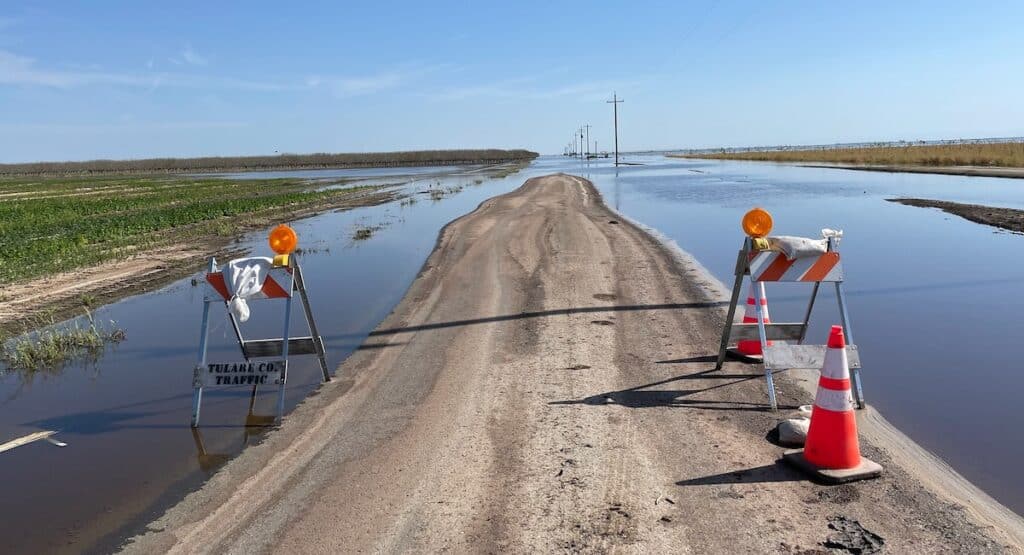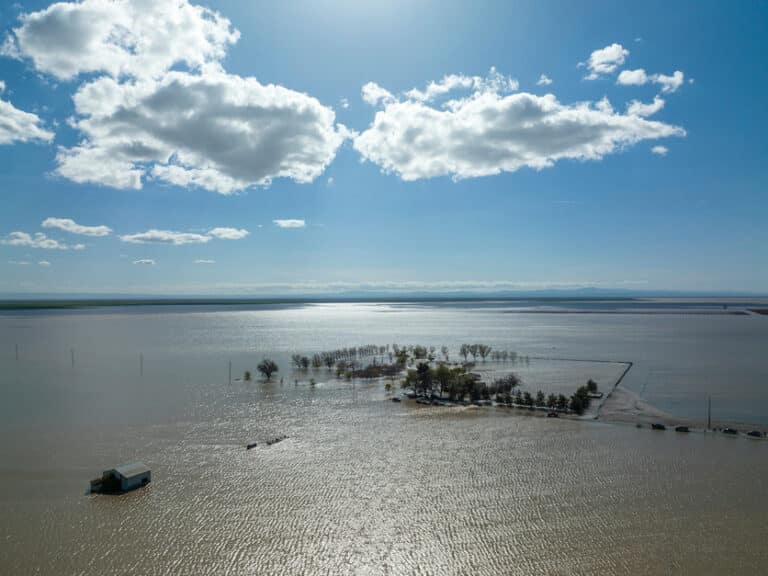Anticipated flooding from spring runoff in the San Joaquin Valley threatens this vital agricultural region.

Editor's Note: The series of devastating storms that pulled California out of its decade-long drought last winter also left parts of the state under water. In the San Joaquin Valley, the flooding affected the resurgence of Tulare Lake, once the largest body of freshwater west of the Mississippi. Early spring and warm weather now threaten even more potentially catastrophic flooding as a historic snowpack in the Southern Sierras begins to melt, endangering local farmworker communities and one of the farming regions largest in California. Climatologist Daniel Swain of the Institute for Environment and Sustainability at the University of California, Los Angeles says this "whip" between prolonged dry spells and heavier rainfall will become an increasingly pronounced feature of California's climate as the planet is heating up and the state needs to do more to prepare.
Were last winter's torrential rains an omen of things to come for California?
California is no stranger to very wet winters. There is a long history of years being much wetter than average. But that feature is expected to be an increasingly prominent part of California's weather in a warming world. On the wet side, we expect to see more extremely wet winters and also more intense and wetter individual storms.
What does this indicate in terms of future drought conditions? Is the picture clear here in California?
At this point, the amount of global warming that has already occurred has caused the intensity of extreme precipitation events in California to be between 5 % and 15 %. This does not mean that California's average rainfall is in danger of this amount. In fact, it hasn't really changed at all. In any case, it has decreased slightly. But this whiplash is one of the hallmarks of California weather in a warming world. Some parts of the state, especially the central and northern regions, have experienced both the wettest and driest years in the last 10 years in over a century of records.
So what you're saying is that the total amount of rain California receives can't change, but when it does rain we can expect those events to be more intense. Is this correct?

Yes, which of course increases the risk of flooding. You can have 20 inches of rain over the course of a year and that be a very average year; but you could also have 20 inches of rain in 3 weeks and find yourself in a flood emergency. So how fast it falls is very important. It is also true that the rest of the time it can be increasingly drier.
How is the state preparing for these weather events of longer dry spells and more extreme and potentially destructive flooding?
Well, you can't take a myopic view of water scarcity or flooding. You have to be thinking of both at the same time, jointly managing drought and flood risks. You really can't separate these two aspects. And to our detriment, is this how we have historically handled floods and droughts in California, dealing with them as completely separate issues? We have to stop doing that.
How is the joint management of drought and flood risks perceived in practice?
It means actions like strategic groundwater recharge, diverting potentially dangerous floodwaters to minimize short-term damage and provide us with long-term benefits. It could be about building canals and conduits. Some people are proposing that more dams be built. The reality is that we have already dammed all the big rivers. And while dams are great for storing water, in a hot climate they will be used with extreme responsibility.
The flooding has caused Tulare Lake to reappear and local farming communities in the Central Valley have been inundated. With more and possibly worse flooding to come as the Sierra snow melts, what are the existing concerns regarding the region?
I'm not sure it's physically or economically feasible to quickly pump the water out of the Tulare Basin once it is deeply flooded. What if there are no realistic means to get the water out quickly? there will be a lot of contamination. Isn't this a pristine freshwater body? It will be full of fertilizers, pesticides, sewage, and a host of commercial chemicals making their way into floodwaters. And the problem is that it will happen there and it will leak for a long time? There is a large part of the San Joaquin Valley whose future is uncertain right now in terms of what could happen in the next few weeks.

What is your perception of how actively California officials are preparing for this? It seems that much of these decisions are being left up to local counties and even residents to figure it out.
It absolutely is, even to the extreme point where each of the big landowners are making decisions, unilaterally, that flourish tens of miles of people living in those areas. This situation is extremely undemocratic, one might suggest. In some cases, a person can make a decision out of self-interest especially considering what will harm his land the least? And this decision is often directly related to what would harm tens of miles of people because if their land doesn't flood it increases the likelihood that someone else's land will flood. The power dynamics here are very asymmetrical.
This almost feels like a microcosm of the broader problem of climate change. We know disaster is coming, but we do little or nothing to prepare, leaving the most vulnerable to fend for themselves.
Why the southern San Joaquin Valley has more challenges than other places is partly because much of the region is controlled by large agricultural landowners? who have an inordinate degree of control even in relation to state or federal agencies. Therefore, there is not much supervision. If you own a lot of land, you have enormous power at this time. That is not so true in other places, where there is a patchwork of ownership and where the state has more control, such as in the northern parts of the valley. Of course it is a region that is also very vulnerable to flooding, but the level of organization and state intervention is certainly higher; "Wild West".
Climate models predict that California may enter an El Niño weather pattern later this year. What does that mean in terms of our current challenges?
There is about an 80 percent chance of it happening. Currently we do not know how serious it will be? there is a 40 to 50 percent chance that it will be a strong event. And the relationship between California precipitation and a strong El Niño weather pattern is quite strong, especially in central and southern California. Meaning that if these probabilities hold, chances of another wetter-than-usual winter next year will be warded off. What if we head into next winter with existing flooding in the Tulare Basin? that will influence this conversation about your destiny in the long run.
To read the note in its original language? English? Click here.
You may be interested in: Young people hold webinar for climate action in the framework of Earth Day


